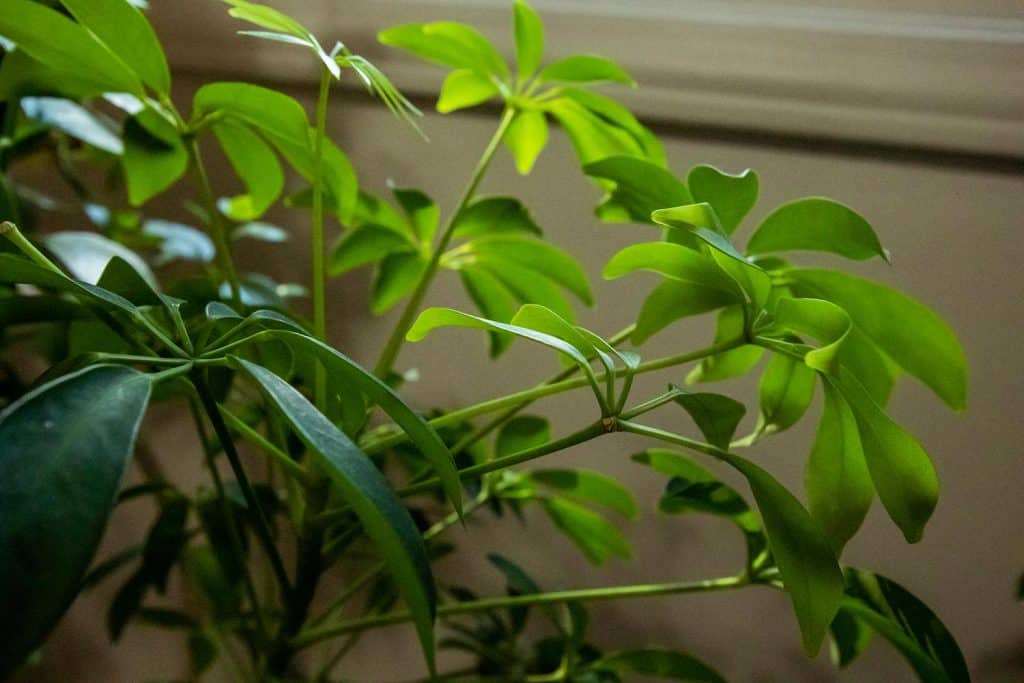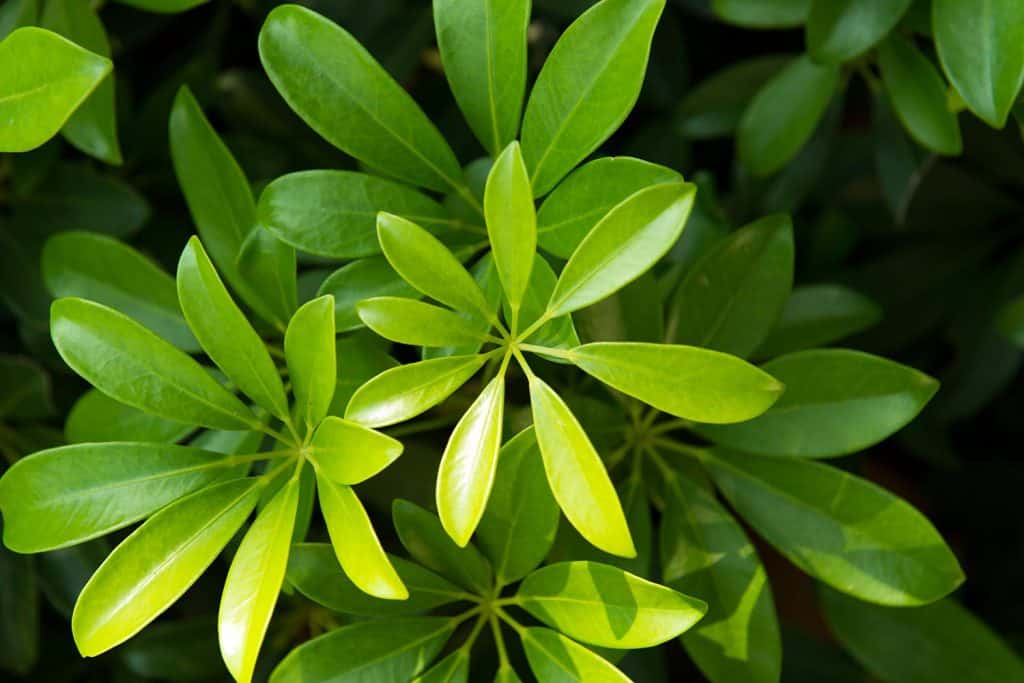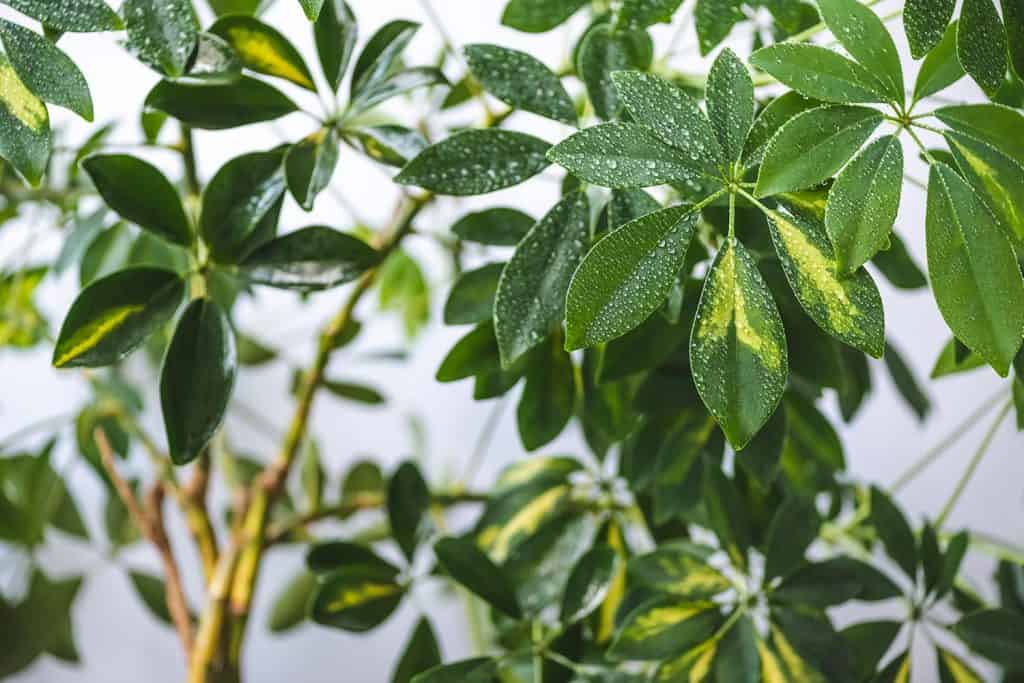Schefflera, commonly known as umbrella plants, are popular and make for hardy dashes of green in many households. However, if cared for improperly, these houseplants will begin to shed leaves. So, you are wondering why your Schefflera is losing leaves. Well, in this post, we gather up-to-date gardening guru information to answer your question thoroughly.
Schefflera lose leaves when they experience improper growing conditions. Issues to monitor include the following:
- Amount of water
- Type and amount of light
- Soil type
- Soil nutrients
- Pests/disease
- Physical stress
Keep reading the rest of this post for details on each of the above bullet points. This guide provides all you need to diagnose and treat your Schefflera leaf dropping issue. To conclude, we answer a few questions related to the topic of this post.

Contents
Why Is My Schefflera Losing Leaves?
First of all, it is normal for Schefflera to lose a few leaves every now and then. The leaves get old and naturally die and then fall. However, if you notice significant leave die-off, this is a sign of a more serious problem.
The following sub-sections cover the main issues that Scheffleras face that cause them to lose leaves. To learn more about Schefflera and similar indoor plants, read this article: "11 Indoor Trees That Are Hard To Kill."

Amount of Water
Improperly watering is probably the most common cause of Schefflera leaf loss. Both overwatering and underwatering this houseplant will lead to leaf drop. Generally, Schefflera prefers constantly damp soil. Both soggy soil and bone dry soil will lead to plant health problems.
Overwatering
Schefflera is particularly sensitive to overwatering. After all, we see a plant that is under stress and we water it - it is close to home gardener instinct. However, if the soil constantly stays soggy several plant issues may arise.
First of all, the roots cannot access the nutrients in the soil when there is too much water. This lack of nutrients then leads to leaf loss. Further, long-term overwatering will lead to root rot and encourage pest growth.

The moral of the story is, if the soil is more than just damp, cut back on the watering, and you may see the leaf loss stop and new leaf growth begin. Signs of overwatering include black spots on leaves and leaves that become discolored without drying out.
It is critical that there are holes in the bottom of your pot, or even rarely watering can lead to overwatering symptoms. This is because the roots and soil are never allowed to dry out.
If you must grow your Schefflera plant without drainage, follow the advice in this great article: 4 Houseplants That Don’t Need Drainage [& How To Grow Any Plant with No Drainage]
Underwatering
While Schefflera is relatively drought resistant, every plant has limits. If your umbrella plant is left dry for too long, the leaves will begin to dry out and eventually fall. Hard, dry soil and crinkly leaves are sure signs of underwatering.
Now, remember, Schefflera does not like to be overwatered. This means that the solution for underwatering is consistent light watering, not too much water once you realize the problem. If the soil is more or less than damp, you are watering improperly.
How to Properly Water Schefflera
To properly water Schefflera, wait until the top 1-inch of soil is dry. Then, fill the top of the pot up and let the water drain through to the saucer. Re-water once the top 1-inch is dry again. This regimen gives the soil a good flush and ensures that the plant does not get overwatered.
It is also wise to use room temperature water to not shock the root system in any way. Further, your Schefflera will need more infrequent watering during the cold season because of the concurrent slowdown in growth.
Type and Amount of Light
Umbrella plants prefer bright yet indirect light. This trait is inherited from their native habitat of the jungle understory. Therefore, if your Schefflera is getting very low light or direct light - leaf loss may result.
While early morning and late evening direct light are ok, mid-day direct light, even through a window will overstress your Schefflera. Signs include dry and crispy leaves without water stress and, of course, leaf loss.
To remedy the incorrect light, ensure that your Schefflera has midday shade by moving the plant further from a window. Or, if the plant is getting very little sun, consider moving it closer to a window or outside light source.
Soil Type
Scheflerra needs soil that both drains well and dries out relatively quickly. If the soil is too compact (think about heavy clay soil) the water will sit for a long time without drying. Further, the roots of the umbrella plant will have a much more difficult time with healthy growth.
If the soil is just too compact, it is probably worth repotting your Schefflera to more well-drained lighter soil. This product is relatively affordable at most gardening and home improvement stores.
Click here for an indoor potting soil from Amazon.
But remember, even soil that starts out as loose and well-drained will compact over time. This means that you might want to repot your Schefflera even if it started out with high-quality potting soil.
Soil Nutrients
Usually, Scheffleras get all the nutrients they need from the potting soil. This means that overfeeding them is more common than underfeeding them. However, both lack of nutrients and too many nutrients can lead to umbrella plant leaf loss.
Too Much Fertilizer
Signs of too much fertilizer include splotchy leaves that exhibit bright colors. This sometimes coincides with leaves that look dry without an actual lack of water. If you fertilized your Schefflera recently or recently changed the soil, overfeeding may be the cause of the leaf loss.

To remedy this, heavily water the soil over a short time period. Flush with water over and over until the drained water starts to run more clearly. Alternatively, you might want to repot your umbrella plant to lighter potting soil.
Not Enough Fertilizer
A lack of nutrients will also lead to leaf drop. Signs are undersized leaves and pale-colored leaves. To remedy, water in or top dress a light fertilizer mix. Since overfeeding and underfeeding exhibit similar signs. Only add about half the recommended dose of fertilizer to see if the plant begins to improve.
Pests/Disease
Common indoor pests and diseases include powdery mildew, spider mites, and other fungal infections. Generally, if you keep your plant properly watered and in a healthy location it will be able to combat all but the worst pest infestations.
Bugs
Click here for neem oil from Amazon.
Usually, bugs are easy to identify through visual inspection. If you do have a bug problem, lightly spray the leaves with insecticidal soap such as neem oil. If this doesn't work, research remedies more specific to your bug infestation.
Fungus or Bacteria
Click here for an anti-fungal plant spray from Amazon.
Signs of fungus and bacteria include black spots on leaves and powdery growths on leaves and/or stems. First, take the time to remove all infected leaves and areas and dispose. If this does not work, try an over the counter anti-fungal or anti-bacterial product.
Physical Stress
Schefflera plants are very sensitive to physical stress. Cold, drafts, movement, and repotting can all lead to leaf loss.
Cold
Umbrella plants are native to tropical climates; because of this, they do not do well if it gets too cold. Cold stress can stem from being too close to a window or from a home that is too cold during the winter months.

Try moving your plant closer to a heater and/or away from a cold window and see if that stops the leaf loss issue. When moving your Schefflera, take steps to be as gentle as possible so as not to shock the plant even more!
Drafts
Occasional cold drafts are not on the umbrella plant's list of proper conditions. To avoid this, consider moving the Schefflera further away from exterior doors. Or seal of leaking areas in your home that are letting cold air in.
Movement
Schefflera are sensitive to being moved, especially serious moves like repotting. If you find that there is leaf loss after reporting or a change of location, first, give your plant some time. If the new location or pot is appropriate, your umbrella plant will eventually acclimatize and get back to healthy growth.
If the move is causing prolonged leaf loss, it is likely that your plant is not receiving proper water, light, nutrients, or is routinely getting too cold.
How do you revive a Schefflera plant?
Revive your Schefflera plant by following the above advice for watering, soil, nutrients, light, and location. To give your plant a boost, it can also be helpful to increase local humidity with a humidity tray or a humidifier.
How do I know if my Schefflera needs water?
As discussed above, your Schefflera needs water once the top 1-inch of soil is dry. Other indications are dry and crackly leaves and leaf loss.
Should I mist my Schefflera?
Since Schefflera enjoys a higher humidity than what is present in most of our homes, occasional misting will improve leaf health. Simply take a spray bottle of clear water and lightly mist the leaves from top to bottom. Be careful, over misting can lead to mold, mildew, and bacteria growth.
How do you keep a Schefflera healthy?
Keep your Schefflera healthy by following the advice contained in the above discussion. Highlights include damp but not soggy soil, bright indirect light, and soil that drains well.
In Closing
In this post, we answered the question of why your Schefflera plant might be losing its leaves. We cover the main causes of leaf loss in this popular indoor plant. Good luck!



